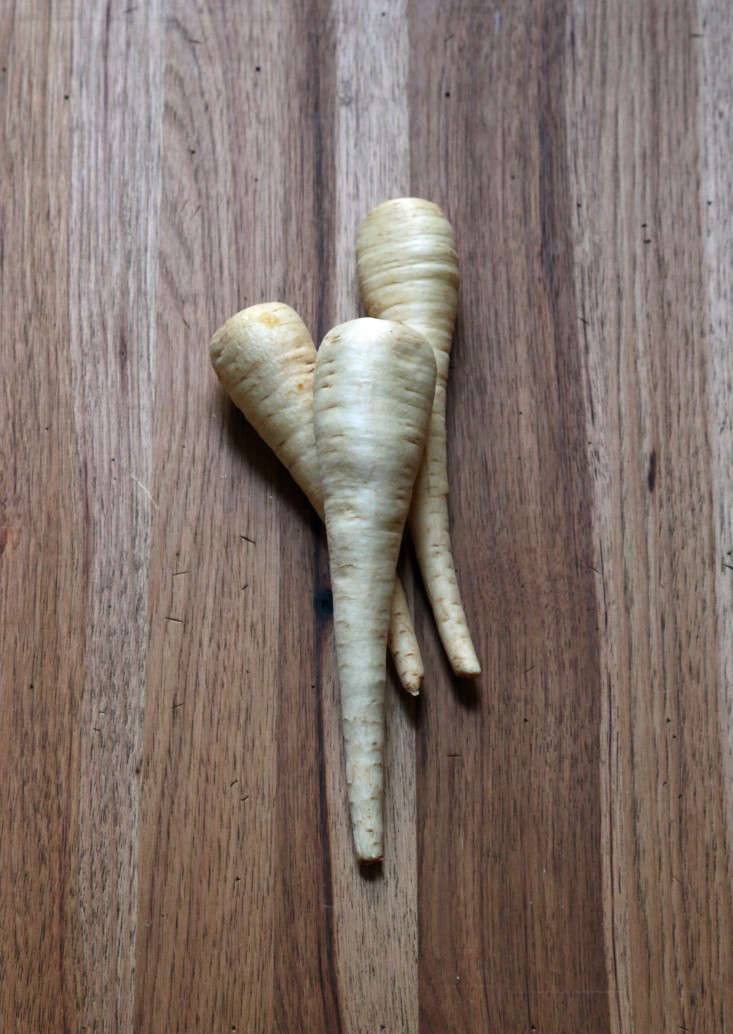Wintertime at the farmers’ market can be a daunting affair. Vegetables in the winter develop thicker skins–root vegetables, stocky greens, everything covered in a layer of dirt. Just as it takes time to persuade that surly farmer to soften, going local in the winter requires dedication, friendliness, and an open mind. Grab your peelers, square your shoulders, and soon these hard to embrace veggies will be bright spots of flavor, nutrition, and joy in your winter landscape.
Photographs by Erin Boyle.

Parsnips
The unsung cousin to everyone’s favorite orange vegetable, the carrot, parsnips feature prominently in many winter farmers’ markets. While the hairy, thick peel may scare you off, parsnips’ exterior belies a smooth, sweet, light flavor that gets sweeter if harvested after the first hard frost.
No time to peel and slice and boil? Just peel the parsnip and then grate the flesh into your salads, on top of toast and avocado, or in any dish needing a shred of highly nutritious vegetable. Parsnips boast lots of folate, manganese, fiber, and vitamin C for just a few calories. And if you do have the time to make and taste a creamy, peppery, warming parsnip soup, you’ll understand why the Romans considered this humble root an impressive aphrodisiac.

Collards
Poor Collards. Ever since kale burst onto the scene, with its cutesy curls and hipster street cred, collards have been patiently waiting by the phone. Do yourself a favor and make the call–collards are a perfect winter green. They do well braised and steamed, sautéed or stewed. They can hold up to the hearty flavors of ham or bean, and actually taste better when cooked longer, a rarity in the greens world. It took a Southern roommate (of course! to show me the light on collards–she served them non-traditional style with mashed potatoes, malt vinegar and red onion, and I haven’t looked back since.

Turnips
I’ll never forget the first time I had a really good turnip. In a hungry daze while working on a farm, I plucked one out of the ground, brushed off the dirt and bit. To my surprise, the harukei turnip tasted sweet, juicy, and fresh, with just a hint of spice–not at all a Scarlett O’Hara moment.
While the Japanese varieties can be eaten raw and taste sweet, traditional turnips (the white and purple ones) benefit from being steamed or sautéed, especially with lots of grass-fed butter, salt, and pepper. The trick to turnips is selection–find ones at your market with bright green leaves, touch to make sure they have firm, even skins, and aim for no bigger than golf-ball sizes. You’ll never go hungry again.

Crosnes
When farmers and grocers first tried to sell Crosnes (or Chinese artichokes) in the States, they marketed them as “white bait.” If you see a basketful of this strange little tuber, you can see where they got the imagery, but really? How about “crunchy delights” or “nutty pearls” or “better than a radish?” I can see where the marketers struggled, but do not let the name, or the look, of these babies fool you. The tiny, caterpillar-shaped tubers taste like a mix between a water chestnut and a Jerusalem artichoke. They can be pickled, boiled, steamed, fried, sautéed or eaten raw, and don’t require much in the way of peeling or chopping. Try them in salads, steamed with a butter sauce as the French do, or cooked with asparagus, fish or lemon.

Cauliflowers
I just don’t see how you could not embrace these jewel-colored baby cauliflower heads. Cauliflower is another wintery vegetable that seems naturally suited to warm you through snow days, slushy streets, or even, heaven forfend, a certain polar vortex. The carb-y, starchy, meaty texture cries out for hearty soups, stews, braises or stir fries. For an extra-special cauliflower dish, try crumbling the heads into small florets, lightly toasting on a cookie sheet, and using the pleasantly textured result as the base for a salad, a fried egg, or thin strips of sautéed tempeh. Your body as well as your taste buds will thank you–cauliflower’s been heralded as a cancer-fighting, detoxifying, and anti-inflammation miracle worker.

Brussels Sprouts
The health benefits of this cruciferous vegetable sometimes seem to have been impressed upon us since birth, or since high school nutrition class at least. Let’s ignore the health benefits, then, and skip to the fun part–eating them. Brussels sprouts are oft overlooked because they are oft overcooked. When they are cooked for too long, Brussels sprouts emit an unpleasant, sulfurous odor and take on a chewy, bland texture. Not what you want. To shorten cooking time, peel off the very outer leaves and quarter or even cut into eighths. Try steaming for tender, bright results or experiment with julienning raw in a salad with dried fruit and soft cheese to balance the flavors. Brussels sprouts hold up well to tangy, tart flavors such as lemon, mustard, or vinegars. If you’re a green juice or smoothie fanatic, you might want to try juicing or blending these little guys–tons of health benefits, no messy countertop strewn with sprout parts.

Celeriac
Celeriac is definitely the Quasimodo of the vegetable world. Thick, knobbly skin, covered in hairs and roots, dirt wedged in nook and crannies–this celery plant, grown for the root, does not evoke the imagery that food blogs are made of. But there’s nothing like a rags to riches story, and to mix my Disney metaphors, celeriac definitely could be the pumpkin that becomes a carriage. Peel, slice and dice celeriac into a tasty, mild treat. Discard the skins, and you’re left with a delicate, emerald-white flesh–crisp in salads, creamy in soups, classic in an easy French remoulade. The root lasts for months (!) in a crisper drawer, so you can test-drive your winter vegetable resolve slowly. What dreams may come.
Don’t let vegetables languish in the fridge. See Cheat Sheet: How to Keep Vegetables Fresh Longer.









Have a Question or Comment About This Post?
Join the conversation